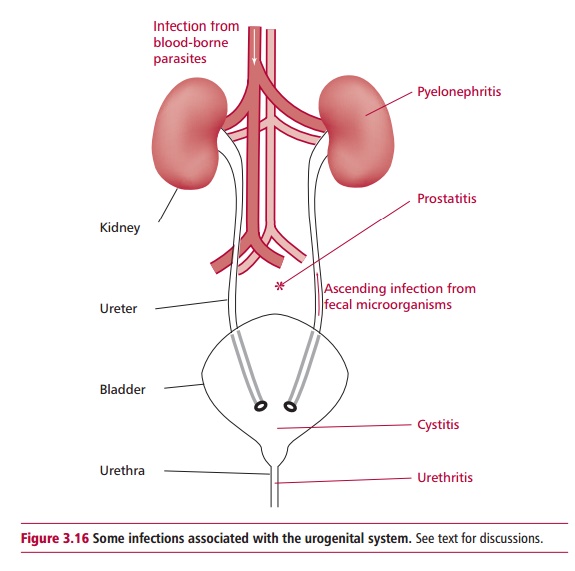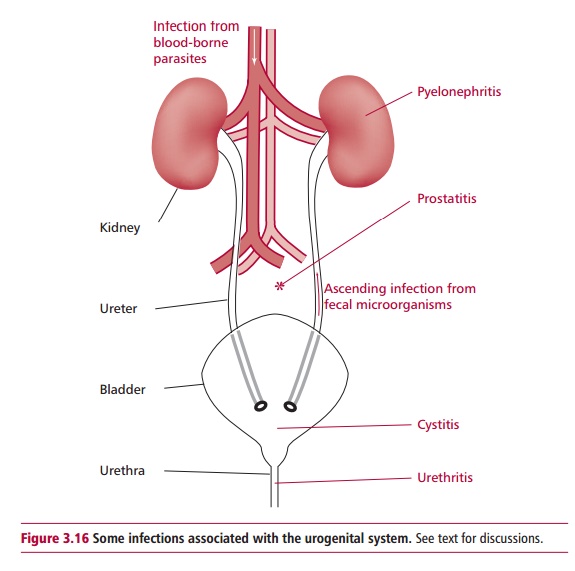Chapter: Biology of Disease: Infectious Diseases and Treatments
Infections of the Urogenital System

INFECTIONS OF THE UROGENITAL
SYSTEM
The urinary system and the genital systems are
subject to infections by specific respective pathogens (Figure 3.16). Urinary tract infections (UTIs) are frequent in the
developed world, with many millions of cases occurring each year. A number of
factors, including diabetes mellitus , scarring, kidney stones, use of
catheters or anatomical peculiarities of the urinary tract all predispose
individuals to UTIs. These originate in the perianal area and move up the
urethra into the bladder causing a short-lived, acute infection

called cystitis. Escherichia
coliis the most common agent causing up to 80% of the relatively
uncomplicated UTIs, like cystitis. Women are more prone than males to cystitis
because of their relatively short urethra and the hormonal changes associated
with the menstrual cycle . Cystitis is readily treated by increasing the uptake
of fluids, particularly of acid drinks like cranberry juice, which causes
increased flushing of the bladder, and by the use of antibiotics.
Unfortunately, reinfections are frequent.
Pseudomonas
aeruginosa has been known to cause UTIs followinghospitalization. Similarly, infections by
Enterococcus faecalis and Klebsiellapneumoniae have followed organ
transplants .Unfortunately,these
organisms often show multidrug resistance against antibiotics. Thrush in the
bladder, caused by the yeast Candida
albicans can also occur following antibiotic treatment.
There has been a large increase in the incidence of sexually transmitted diseases (STDs) in the UK in recent years. Sexually transmitted diseases can affect the urinary system and the genital tract and are caused by a wide range of different pathogens. Human papilloma virus (HPV) can cause anogenital warts (condyloma acuminata). Strains 16 and 18 of HPV cause lesions in the cervix that are involved in the development of cervical carcinoma. Infection with Herpes simplex virus (HHV-2) can lead to genital herpes with painful ulcers and vesicular lesions of the genital mucous membrane. Infection with human immunodeficiency virus leads to acquired immunodeficiency syndrome (AIDS).
Some types of Chlamydia
trachomatis are among the commonest causes of STDs producing local inflammations
of the urethra and cervix. In contrast, other types are highly invasive and
infiltrate the lymphatic system leading to necrosis (lymphogranuloma venereum).

The most widely known STDs are probably gonorrhea and
syphilis caused by the bacteria Neisseria
gonorrhoeae, a Gram-negative diplococcus, and Treponema pallidum a spirochete (Figure 3.20 (A) and (B))
respectively.Gonorrhea, a common STD, is a pelvic inflammatory disease whose
major symptoms include a purulent inflammation of the uterine cervix and
urethritis. In some women, however, the infection may be relatively
asymptomatic and may go unnoticed. Syphilis was thought to have originated in
the Americas and been brought to Europe by sailors on the Columbian
expeditions. More recent evidence suggests that it was present in the Old World
long before this. Treponema
spirochetes can enter through mucous membranes or minute abrasions in the skin
during sexual acts. The infection shows three stages of pathogenesis.
Initially, an ulcer called a chancre
develops at the site of infection. The infection then spreads to nearby lymph
nodes causing them to swell and harden. Secondary syphilis develops after one
to three months. It is characterized by the presence of highly infectious
lesions on various parts of the body. The disease may lie dormant for many
years but, if not treated with antibiotics, will develop into tertiary syphilis
causing inflammations of the aorta and CNS. Dementia, heart attacks and death
can all result. Patients with tertiary syphilis cannot infect others with the
disease. Some patients may develop benign late syphilis, which is usually rapid
in onset but does respond well to treatment. It usually begins three to 10
years after infection and is characterized by the development of gummas. These are tumor-like growths of
a rubbery consistency that are most likely to affect the skin or long bones but
can also develop in the eyes, mucous membranes, throat, liver and stomach
lining. However, since the use of antibiotic treatments for syphilis they are
increasingly uncommon.
The protozoan Trichomonas
vaginalis (Figure 3.21) is a
frequent colonizer of the mucosal membrane of the urogenital system. It is
generally asymptomatic

Related Topics